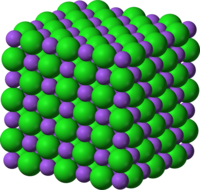
Photo from wikipedia
A natural rutle sample was measured by in situ high-temperature X-ray diffraction (XRD) patterns, as well as Raman and Fourier transform infrared (FTIR). Crystal structure is refined on the sample… Click to show full abstract
A natural rutle sample was measured by in situ high-temperature X-ray diffraction (XRD) patterns, as well as Raman and Fourier transform infrared (FTIR). Crystal structure is refined on the sample with 1.4 mol.% Fe and 510±120 ppmw. H2O. The unit-cell and TiO6 octahedral volumes are expanded by 0.7%–0.8% for Fe3+ incorporation, as compared with the reported Ti-pure samples. The volumetric thermal expansion coefficient (α, K−1) could be approximated as a linear function of T (K): 4.95(3)×10−9×T+21.54(5)×10−6, with the averaged value α0=30.48(5)×10−6 K−1, in the temperature range of 300–1500 K. The internal Ti-O stretching (A1g and B2g) and O-Ti-O bending (Eg) modes show ‘red shift’, whereas the multi-phonon process exhibits ‘blue shift’ at elevated temperature. The rotational mode (B1g) for TiO6 octahedra is nearly insensitive to temperature variations. The OH-stretching bands at 3 279 and 3 297 cm−1 are measured by high-temperature spectroscopy experiments. Both the IR-active and Raman-active OH-stretching modes shift to lower frequencies at higher temperature, with the signal intensities decreasing. And after quenching, we expect about 43% dehydration around 873 K, and 85% dehydration at 1 273 K for this hydrous sample.
Journal Title: Journal of Earth Science
Year Published: 2020
Link to full text (if available)
Share on Social Media: Sign Up to like & get
recommendations!